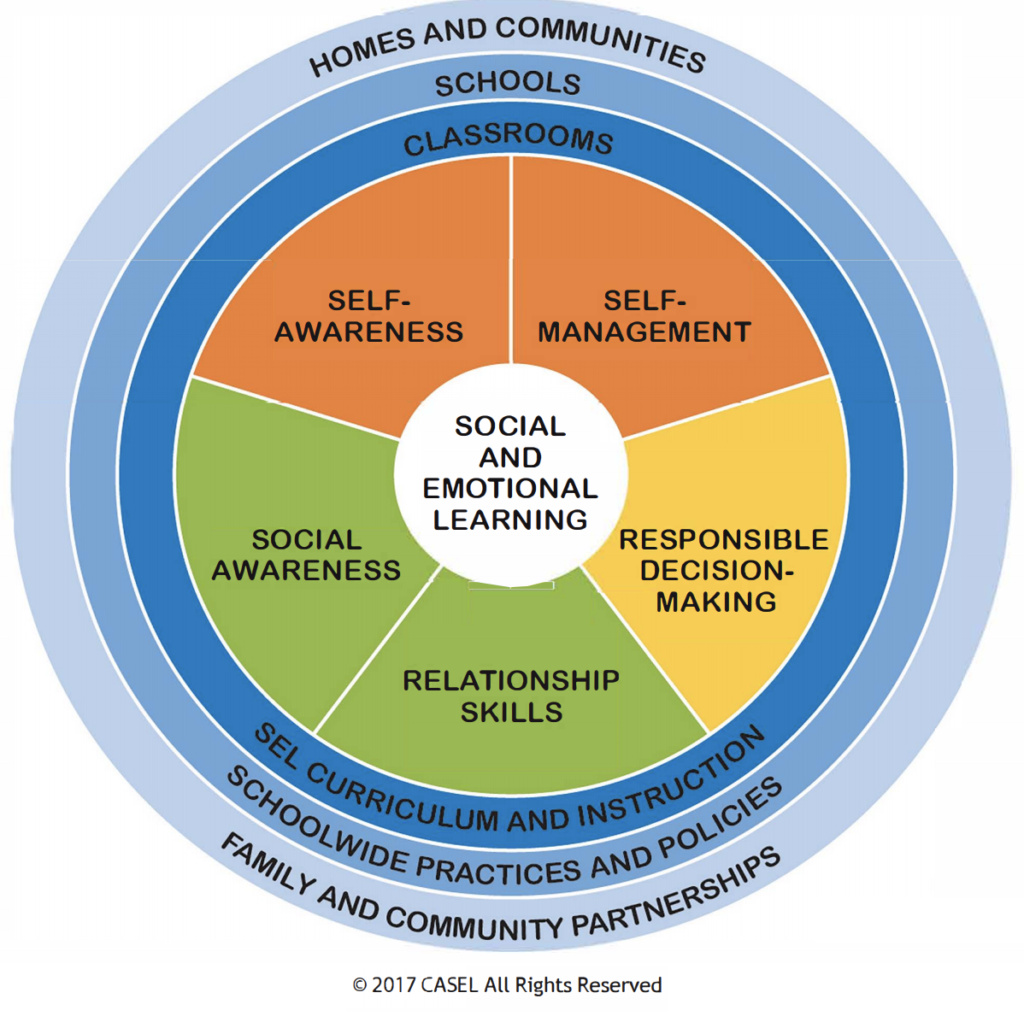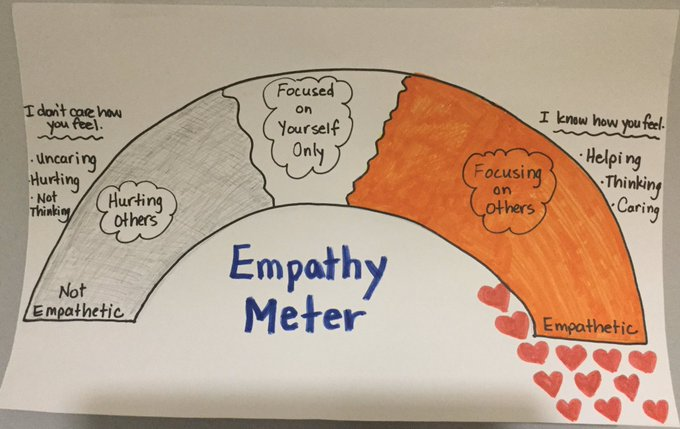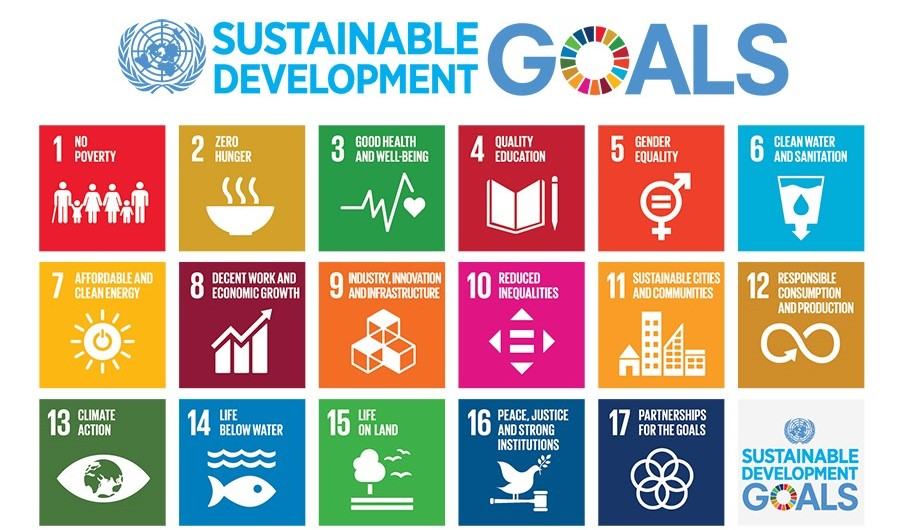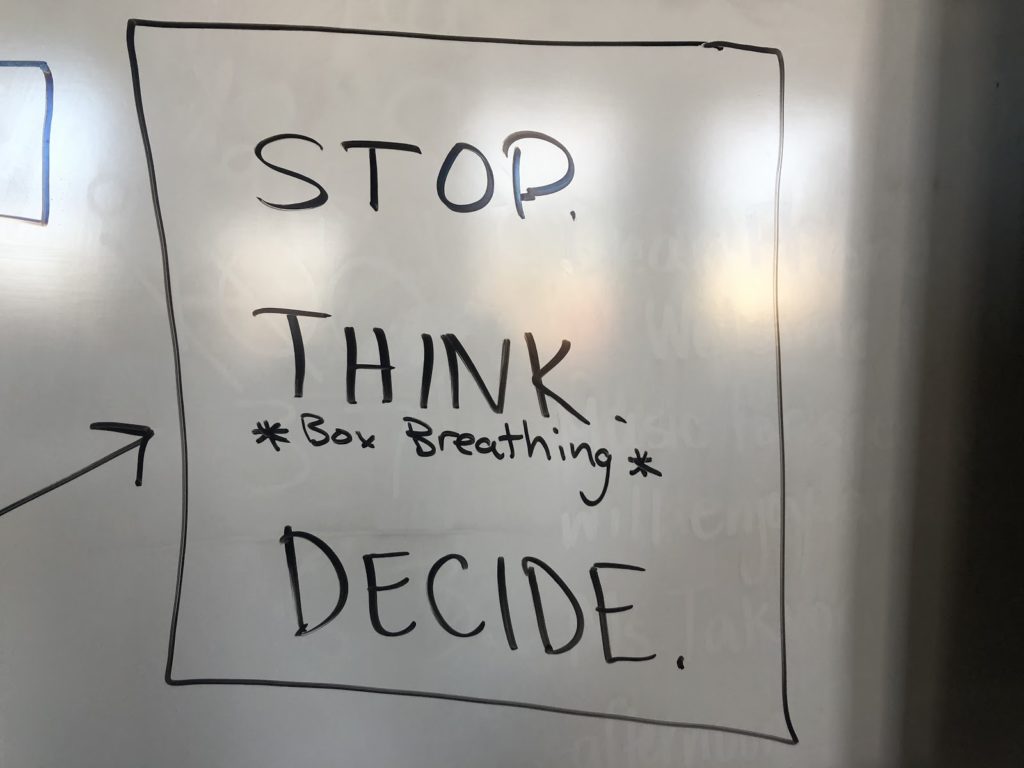Hearken to the interview with Wendy Turner:
Sponsored by World101 and Blue Apple
I’ll always remember the day when a crimson rubber bracelet was my most vital accent. After starting our common morning routine, I used to be confronted by an indignant colleague in my classroom. We began to have interaction in a heated dialog—proper in entrance of my college students. I knew this was dangerous. I knew my college students had been watching, and I knew I needed to get my social-emotional home so as, quick!
After a few minutes, we ended the dialog, however the points had been unresolved. After I shut the door, I didn’t return to the morning assembly. I couldn’t, not the way in which my feelings had been at that second. I actually couldn’t educate. So I walked over to a small basket that holds crimson, inexperienced, and yellow rubber bracelets. All of us put one on each morning to share how we’re feeling with out phrases. I took off the inexperienced one I used to be carrying and placed on a crimson one, whereas 20 pairs of scholar eyes bored into my soul. I merely advised my college students I wanted to chill down, then went over to our respiration bucket—or cool-down space—and breathed deeply for a number of minutes whereas they continued.
I used to be then capable of return to my college students and my job in a way more productive emotional state. I modeled EXACTLY what I might need them to do in the identical state of affairs. I later realized that this second was an unbelievable present, an opportunity to point out my college students the way to deal with troublesome feelings once they come up unexpectedly. It was my alternative to mannequin self-awareness and observe grownup social-emotional studying.
Social-Emotional Studying: It’s in every single place in schooling in the present day. From Twitter chats to skilled growth to crew conferences, SEL is extensively mentioned, debated and embraced in several methods with a number of emotion (no pun meant). And rightly so, for my part: Social-emotional studying is the important thing to educational achievement; it’s the wonderful artwork of being a profitable human; and it’s the floor flooring of studying. I don’t imagine any scholar can entry and unlock their full educational potential with out first accessing and unlocking their full social-emotional self.
So what’s SEL precisely? CASEL, the Collaborative for Tutorial, Social, and Emotional Studying, defines SEL as “how youngsters and adults be taught to know and handle feelings, set objectives, present empathy for others, set up optimistic relationships, and make accountable selections” with 5 competencies: self-awareness, self-management, social consciousness, relationship abilities, and accountable decision-making. The graphic beneath illustrates this properly.

What’s the best option to educate and develop these competencies? Many have considerations about constructing within the time to show SEL in addition to confusion over precisely the way to do it. Do we’d like a curriculum binder with classes? Do we’d like an SEL abilities block? Possibly. However I feel a greater reply is correct in entrance of us. The higher reply is us and it begins with modeling the competencies we want to see in our college students each single day. It means wanting deep inside ourselves and figuring out what we’re good at and what we have to work on, and fascinating in that work proper earlier than our college students’ eyes.
Doing this type of work proper in entrance of our college students will not be for the faint of coronary heart, however doesn’t it make sense? How can we ask our college students to have a progress mindset or use empathy and get together with friends if we don’t authentically do it ourselves? To actually germinate and develop, SEL ideas should be embedded within the partitions of our lecture rooms in addition to the material of our day by day studying experiences. We lead by instance, modeling each profitable and difficult moments.
One good place to start out is to have a look at every competency, get actually, actually sincere about the place we’re with every of them, then discover methods to mannequin them to one of the best of our potential.
Competency 1: Self-Consciousness
That is all about setting objectives, understanding the strengths and weaknesses you possess, and cultivating a progress mindset. To mannequin this in your college students, share the objectives you’re engaged on, your plans to get there, and the struggles you encounter alongside the way in which.
I’m nice at numerous issues, however I’m a very dangerous cook dinner. Figuring out this, I routinely attempt to make meals with success to develop my confidence and present my college students and my household that I can and can attempt. It doesn’t assist that my husband is a unbelievable cook dinner.
Final yr my classroom was related with a category in Nigeria utilizing a tech device known as Empatico, so we discovered about Nigerian tradition as a part of the method. One actually cool truth we came upon was that they eat a bean cake known as Akara for breakfast. My class instantly requested if we may attempt it. No drawback, I mentioned. Besides that I needed to cook dinner it myself.
Frozen with worry, I went residence decided to make this meals for my college students. Full disclosure: my husband does the entire cooking in my home. It turned out it was SO a lot work to soak and peel beans after which fry the desserts. They weren’t excellent, however I used to be capable of make them. I took photos and movies of the method and shared them with the category. When college students tried them, they cheered for the Akara and for me. Deep waves of happiness invaded my soul. I had shared my worry with my children, confirmed willpower by arising with a plan to do one thing new, and received it achieved. Then I shared the tip product with folks I care about: my college students. They advised me how proud they had been of me. I can’t overlook that second.
Through the years, I’ve shared coaching plans for working half marathons, being nervous about huge displays and speeches, and my insecurity in braiding my daughter’s hair. This helps college students see me as human and likewise fashions my work on self-awareness and my potential to embrace new experiences. A couple of occasions a yr I assign progress mindset homework the place college students choose a brand new talent to be taught. Over per week they log their time on the brand new talent and their outcomes. This enables them to observe what I’ve proven them.
One other huge a part of self-awareness is cultivating a optimistic outlook. I take advantage of reframing ideas as a option to discover one thing optimistic or good in no matter is troublesome. Reframing doesn’t imply we diminish exhausting issues or dismiss them. As an alternative, we take a look at them one other option to see one thing as not fairly so dangerous. Every week I share with my class one thing troublesome I’m going via, after which I reframe it. For me proper now, a kind of difficulties is enjoying ping pong with my household. We have now two youngsters. Everybody is actually good at it and I suck. I’ve to work on my emotional regulation whereas I get crushed within the video games recurrently, generally mercilessly taunted by moody youngsters. So I preserve enjoying to get higher. I reframe the expertise as time spent with my children and energetic time and entry my progress mindset round ping pong abilities. It’s a win and I get higher!
With my college students, we undergo group constructing circles the place we take a look at a state of affairs and college students provide concepts round reframing it. For college students who wrestle to positively reframe, they’re nonetheless listening to concepts from others on the way to do it as they develop this talent. As with all different talent, observe builds competence and I can see college students get higher at this all year long.
Competency 2: Self-Administration
Self-management is our potential to handle our feelings, plain and easy. How will we preserve our cool and get well after we lose it as we expertise anger, frustration or nervousness in on a regular basis conditions? We mannequin it.
Regardless of my greatest intentions, I don’t stay calm and regular each second in my classroom. That is regular, so I make some extent to point out my college students the way to navigate these generally troublesome feelings. And after I have to, I apologize for my incapability to remain regulated, particularly if it leads to yelling.
Within the instance I shared earlier, I had bodily indicators seem that indicated I used to be going to lose it! Warmth crept up my physique, my ears turned crimson and my cheek began to twitch, a traditional signal that I used to be about to get actually upset. After I modified my bracelet and went to chill off, I actually needed to wait till my inner physique temperature went down, I finished shaking, and the crimson left my face.
It’s actually vital to mannequin recognizing the bodily indicators that your physique goes into stress mode. Then, after we see the indicators, we are able to take into consideration what we have to do to keep away from the meltdown. Dan Siegel, a scientific professor of psychiatry on the UCLA Faculty of Drugs and the founding co-director of the Conscious Consciousness Analysis Heart at UCLA, makes use of a hand mannequin of the mind to offer a concrete option to monitor this modification. A closed fist represents a regulated emotional state whereas an open fist exhibits what occurs after we develop into dysregulated. Studying to note the indicators is extremely invaluable so you possibly can work to attempt to get again to a regulated state. This video does job of explaining this idea of the upstairs or studying mind vs. the downstairs or “lid-flipped” mind.
As a coach for Kristin Souers and Pete Corridor, the authors of Fostering Resilient Learners, I educate adults about this idea so we are able to deliver it to our children and assist help proactive emotional regulation.
I’ll be sincere. I used to be extremely happy with how I dealt with myself that day in entrance of my college students. It was a teachable second. It was the curriculum of actual life. It was not within the lesson plan, however everyone knows that among the most unbelievable and invaluable classes are unscripted, unplanned, interrupting what we thought we might do. However we should see them, embrace them and love them for what they’re: invaluable life classes and an opportunity to mannequin SEL authentically.
Competency 3: Social Consciousness
This competency is all about empathy and appreciating range, folks and views totally different from us. If we are able to discover alternatives to mannequin this for our college students, they are going to in flip get higher at it.
On the seventh day of my instructing profession, one among my college students misplaced his mother to most cancers. I simply went residence and cried. I used to be terrified about the way to help this scholar in addition to the remainder of his classmates. I educate 2nd grade, so fears about loss and parental separation are very highly effective. Whereas my scholar was out together with his household, we held a number of class conferences to specific our fears and speak about methods to be empathetic. When that scholar returned, my class received to see me utilizing empathy as he got here again to the routines of faculty.
A couple of years later, when a former scholar confirmed up in my room wearing the identical garments for 3 days, exhausted from sleeping on a sofa each evening, I let him sleep behind the classroom so we may get to a spot of studying. My college students noticed this and so they received it, stepping over him to place away their coats and backpacks. After I see college students within the hallway or at recess struggling, I ask how I can assist them and what they want. I do that with lecturers too, all of it in plain view of my college students.
Just lately, we had apples for a snack. The extras had been rapidly claimed however one boy requested for some extra; I needed to inform him they had been all gone. One other scholar received out some scissors and reduce his bag of apples in half to share with the boy. That was empathy in motion. After we mannequin empathy authentically, it begins to point out up.
I’ve an empathy meter in my room the youngsters can use to gauge the place we’re as a bunch. There’s a spherical magnet you possibly can slide round on it. Each morning I put it into the middle on the world that claims “Centered on Your self Solely” and children transfer it a bit of or so much to at least one facet all through the day based mostly on what they’re feeling and seeing others say and do. As an example, if somebody will get upset and cries throughout a associate or group exercise and different college students consolation her or him, somebody will slide it towards the orange facet. If somebody is hurtful, it goes the opposite means.

It’s also possible to make educational decisions that construct this competency, just like the partnership now we have fashioned with the classroom in Nigeria. Numerous literature that helps empathy-building is one other option to develop social consciousness (do this social justice e book record right here).
Competency 4: Relationship Expertise
This competency is predicated on our potential to get together with and forge connections with different human beings. CASEL tells us it contains cooperation, negotiating battle and communication abilities. Though it’s simple to hold with people who find themselves similar to you and share your opinions, I make some extent to attempt to speak to and join with as many individuals as potential in my faculty recurrently. Our college group is big with a number of very totally different folks with various views. I be certain that my college students see me partaking in optimistic and productive conversations with custodians, cafeteria employees, mother and father, tutors, different lecturers, constructing mechanics, guests from the district workplace and college students from different grade ranges and lecture rooms as typically as potential.
When our custodian is available in to alter the morning trash after we eat breakfast within the classroom, we are saying good morning to her and I ask her how her child woman is doing as an alternative of silently letting her slip out and in of our room, unseen day by day. When crew members plan discipline journeys or particular occasions for us, all of us genuinely thank them. Final yr we wrote and delivered letters of kindness to one among our Deans of College students after a tough patch, cementing the robust relationship now we have with him and exhibiting appreciation for the whole lot he does day by day. As we journey via the varsity and I come throughout college students who I have to work together with, generally to go with them, generally to redirect them, I all the time introduce myself to them first with a handshake and a smile. I praise hair, footwear, and concepts throughout me. We search for connections after which do good issues for folks.
My earlier instance in regards to the instructor who barged into my room yelling is a good instance of negotiating battle efficiently. The instructor and I recovered from this incident and proceed as respectful colleagues. That is the work of creating robust relationships with the folks round us. It’s the small on a regular basis moments and gestures. It’s swallowing unhelpful remarks and snarky feedback. It’s noticing and never judging. And it’s actually, actually exhausting. There isn’t any magic to this work, slightly a need to have interaction within the steady, sustained effort that yields private {and professional} relationships that matter, work and final. And naturally, now we have to verify our college students see us do it day by day. Relationship constructing is constructed on listening and connection. This text is likely one of the greatest I’ve seen about the way to foster connection in any respect ages. And right here’s an incredible video, made by children, about the way to pay attention nicely:
One other highly effective option to help relationship abilities is to have interaction in teamwork. When a bunch comes collectively round a mission, significantly a service mission or one that may profit others, the rewards are unbelievable. Folks develop a way of function as one bigger unit and relish the great emotions that such a mission can generate as they make a optimistic impression. This additionally strengthens our relationship with the group and the world at massive.
I’m a member of a crew of worldwide fellows who work to deliver concepts to our college students round constructing international competence and social good. I share this teamwork with my college students after which work to create motion with Staff Turner (nickname for our class) in the identical means. Some concepts to contemplate are establishing a faculty backyard, supporting a neighborhood animal shelter, planning and executing a group occasion round serving to the setting, and accumulating objects for these in want. Previously, now we have satisfied our district diet chief to alter breakfast supply from single-use plastic luggage to reusable plastic caddies.
An ideal framework for tasks like these is the United Nations Sustainable Growth Objectives. These objectives define 17 enormous and vital issues on the planet; college students can come collectively and act regionally on any of those objectives to make a optimistic impression. One other profit? This work with a real-world connection and impression is extremely partaking and might complement any core curriculum. Take a look at the graphic beneath and click on right here to be taught extra.

Competency 5: Accountable Resolution Making
Progress on this competency facilities on our potential to make good decisions as we work to resolve issues and navigate on a regular basis challenges in our lives. Probably the most highly effective device I possess to develop this competency and share it with others is my private reflection.
A couple of yr in the past, I engaged in some actually poor determination making that went in opposition to the whole lot I stood for. I used to be unhelpful, impolite, imply and unfavorable when our admin crew was asking lecturers for assist when confronted with a substitute scarcity. I had a chance to assist and I blew it whereas others had been stepping as much as the plate. I violated the model of myself that I labored to place on the market day by day; somebody who’s optimistic, useful and robust sufficient to do troublesome issues. After I analyzed the state of affairs and regarded again on my decision-making course of, I noticed I had not achieved one crucial factor. I uncared for to have empathy for our admin crew. They had been attempting to resolve an issue on a busy morning. I entertained solely my perspective as an alternative of that of others. I noticed this wanting again, not ahead.
The important thing to creating this competency is creating the time and headspace with a purpose to be taught from previous failures. It’s actually exhausting. I do that by getting up early and sitting quietly reflecting on the day earlier than and the day forward earlier than talking to a different human, checking social media, or responding to an e-mail. I’m an early fowl, so this works for me, however everybody can work to seek out that headspace in a spot that works for them. The bathe, the automobile, the kitchen, in a journal, or with music.
Within the second, now we have to recollect to ask a couple of questions as we get able to act. Some are: What am I actually attempting to do? Is this beneficial? Is that this vital? If you find yourself engaged on longer crew tasks and have the posh of planning and time we are able to add: Is that this possible? Is there a greater option to do it? Is that this morally sound, moral, and secure? Constructing in questions at checkpoints and reflection after appearing can support in additional accountable determination making. So typically after we are impulsive, we later remorse our actions. Constructing in that deliberate questioning to sluggish issues down can assist.
With children, I take advantage of a protocol known as “STOP. THINK. DECIDE.” for on a regular basis moments and customary issues. A easy visible within the classroom is a straightforward and useful reminder. Holding weekly community-building circles the place college students share a few time they made a poor determination and the way to do higher subsequent time works to maintain these beliefs entrance and heart.

I actually imagine probably the most highly effective individual in our lecture rooms to help SEL is us. It simply is. Yearly in the course of the first week of faculty, I present my college students a presentation known as “The right way to Be a Nice Human” (you possibly can entry it right here). I do know that there’s completely no means I can count on my college students to embrace the concepts in it with out doing that in a really seen means myself.
One in all my favourite quotes of all time is a widely known one from Haim Ginott, a baby psychologist from Israel, lengthy since handed away. He says “I’ve come to the horrifying conclusion that I’m the decisive component within the classroom. It’s my private method that creates the local weather. It’s my day by day temper that makes the climate.” We’re the climate.
With nice intention, focus, observe, and intensely exhausting work, we are able to create higher climate in our lecture rooms after we pursue social-emotional excellence, embracing these competencies as actual, uncooked, full human beings, exhibiting our college students how to take action alongside the way in which. We don’t want binders of curriculum or hours within the day, slightly the will and skill to embed SEL into each nook and cranny of our lecture rooms by being authentically human, committing to doing higher and sharing our work alongside the way in which.
Since scripting this put up, Wendy has printed a e book on this matter: Embracing Grownup SEL. Click on the hyperlinks beneath this picture to buy in on Amazon or Bookshop.org. (Cult of Pedagogy is an affiliate for each of those websites; this implies we get a small fee on purchases made via our hyperlinks.)
Be part of our mailing record and get weekly suggestions, instruments, and inspiration that may make your instructing simpler and enjoyable. You’ll get entry to our members-only library of free downloads, together with 20 Methods to Minimize Your Grading Time in Half, the e-booklet that has helped 1000’s of lecturers save time on grading. Over 50,000 lecturers have already joined—come on in.

